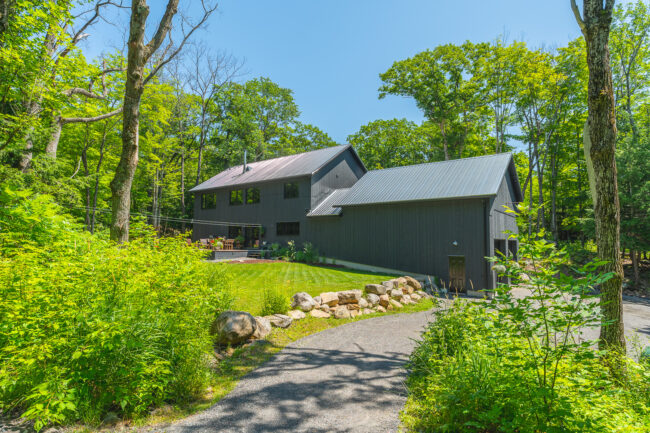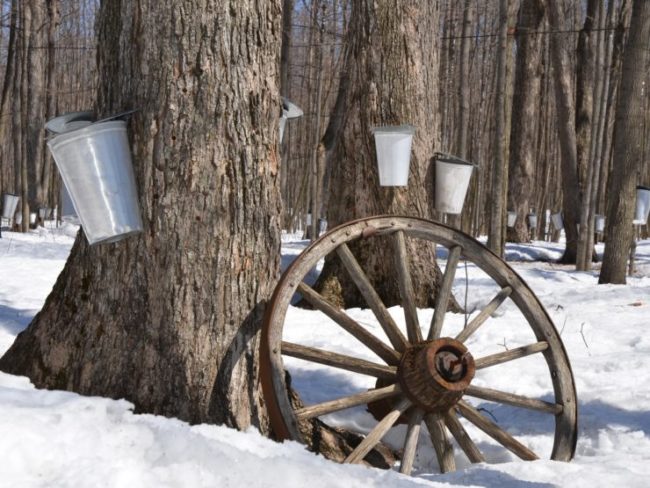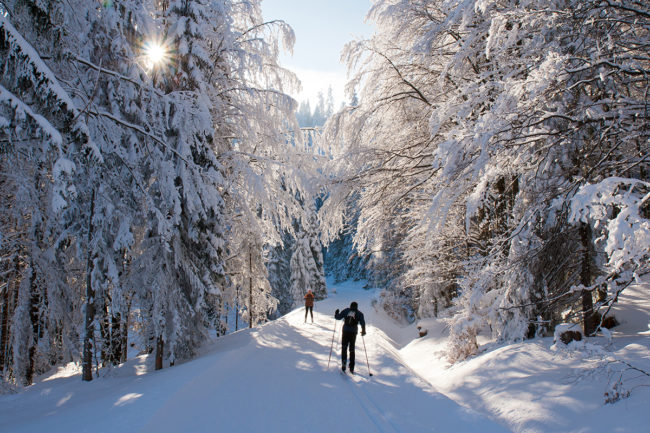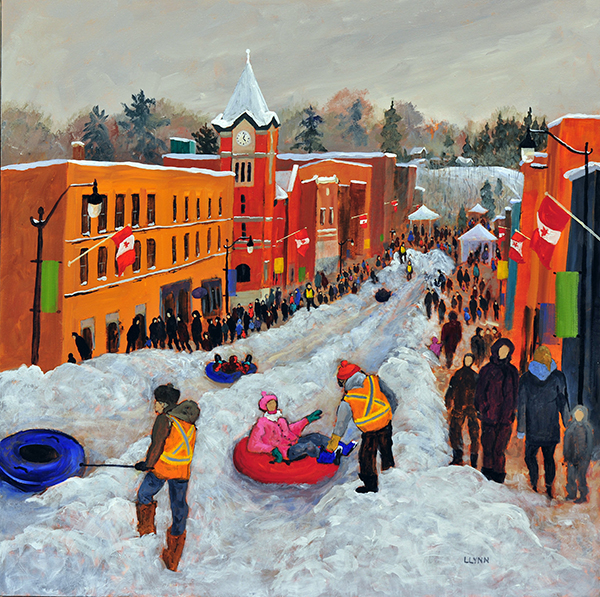Property poor in cottage country: Why legacy landowners can’t keep their land
By Joe O’Connor
PORT CARLING, Ont. — Gord Carr set some old family photos on a wooden counter inside the Carr Greenhouse on Carr Road, a garden centre on the periphery of Port Carling, Ont. It was a sweltering Sunday afternoon in prime Ontario cottage country, doubly so inside the greenhouse, where Carr and his younger sister and business partner Leslie and their respective common-law spouses, Heidi Berninger and Kevin Broad, were doing what they typically do 10 or more hours a day, seven days a week, during the tourism high season: working.
“We can’t afford to stop,” Carr said.
Port Carling is a gateway to lakes Rosseau, Muskoka and Joseph, collectively known as the Muskokas, and sensationally known in media headlines as the “Hamptons of the North,” since the freshwater and pine tree paradise is frequented by the rich, and occasionally famous, some of whom arrive at their waterfront mansions aboard float planes or, more lately, helicopters, and are met by a five-star meal prepared by a personal chef.
But right alongside them are the cash-strapped, unsung locals. People like the Carrs, a fifth-generation Port Carling family, with black-and-white photos depicting the pioneering family members who came before them, not to build palatial vacation homes, mind you, but to carve a living from the northern woods.
Theirs is a much grittier tale of survival, one that doesn’t include a personal chef. District of Muskoka figures show that about 60 per cent of the region’s year-round population of 66,000 or so earn less than $50,000 a year. Year-round employment is hard to find, and even if there were good-paying jobs in abundance, housing is scarce and well beyond the reach of most young families.
The twist in this narrative of opulence in the face of great need is that the Carrs own more land than most of their wealthy neighbours do, well over 100 acres in total, including a stretch of pricey waterfront real estate on Lake Rosseau. They also share something in common with the über rich: big capital gains taxes when they die.
A quick scan of the local real estate listings reveals that cottage prices start at about $1.5 million and zoom past $20 million. But don’t ask the Carrs about selling because they aren’t interested. Instead, they see themselves as “property poor” hangers-on to an irreplaceable family legacy.
“I don’t care about money,” Gord Carr said. “What we have here is something that we could never buy if we got rid of it, and I want to be able to keep this land so that I can give it to my kids.”
Hence the greenhouse, the latest addition to a generations-old, hustle-or-go-bust family enterprise centred around looking after wealthy vacationers’ needs. Carrs present and past have been fixing leaky roofs, planting gardens, storing boats, troubleshooting stinky septic beds, shovelling roofs in winter and cleaning up after cottagers’ messes for as long as anyone in the “Port,” as they refer to it, can remember.
What keeps the siblings going, in addition to their old-fashioned work ethic, is a deep, non-transactional attachment to the land, and an equally deep sense of foreboding that upon their exit from this life — and Carr is pushing 60 while Leslie is knocking on the door of 55 — the capital-gains taxman is destined to stick their kids with a bill they won’t possibly be able to pay.
Harbouring a healthy fear of the tax code is not unique to the Carrs, particularly among the dwindling number of original land grant families still in the area. Once upon a time, pre-Confederation, the Upper Canada government was anxious to populate areas beyond the established settlements. Of course, these lands were already populated by First Nations, but such is the history of our country.
Pioneers started popping up in the Muskokas around the 1840s, drawn by what sounded like the deal of the 19th century: 100 acres of free land. All a settler had to do was clear at least two acres of land, build a 16-by-20-foot residence and live there for five years.
“It sounds easy, doesn’t it?” Sue Daglish, a Port Carling resident, long-time cottager and local historian, said. “But the stunning fact is that 14 of every 15 of the free land grantees couldn’t make it, and they abandoned the grant.”
The ones who stuck it out generally fell into one of three categories: those who happened to get a chunk of what were very rare arable acreages; those who found work in nearby lumber camps, felling the white pines coveted by the Royal Navy; and tourists.
It turns out the Hamptons of the North have always attracted the wealthy. The profile of the well-to-do visitor circa 1880s was a young male from a family of means who, as Daglish puts it, was eager to test his ambitions and “virility” against Mother Nature.
The 87-year-old’s grandfather William Middleton was among those early adventurers. While roughing it in the backwoods, he came upon an abandoned settlers’ cabin and bought the property from the local land grant officer for $100.
Middleton was a lawyer who did rather well, ultimately serving as an Ontario Supreme Court justice for 33 years. There is even a book about him, Middleton: The Beloved Judge, published in 1988. His granddaughter retired to the area with her husband about 20 years ago, and they are equally active on the local scene as anti-poverty activists, as well as being sometime clients of the Carrs.
Leslie Carr designed Daglish’s garden and she tends to her flower boxes, while Gord took one look at an old log cabin that had been damaged by fire, one that another contractor said required $300,000 in repairs, and did the job for $10,000. Other services are rendered at no charge, including smoothing a bumpy gravel driveway and changing tires according to the season.
“Gord and Leslie are very special to us,” Daglish said. “They are doing whatever they can to hold onto their land.”
Daglish and her husband Ted sold a chunk of their land — they still have 36 acres and 1,000 feet of shoreline — and put the money in a trust, knowing full well that a tax bill was looming, and they weren’t getting any younger.
Middleton’s $100 real estate purchase was valued at less than $2,000 in the mid-1950s. By Daglish’s best guess, the property would fetch anywhere from $10 to $15 million today, but, like the Carrs, she is not interested in selling.
Unlike the Carrs, she has a financial ace in the hole: her son-in-law, who has also done very well for himself, and can absorb the tax hit and associated maintenance costs on the property that has been in the family for 145 years.
“I can’t imagine not living here,” Daglish said.
Capital gains were treated as tax free prior to 1972, according to Jason Heath, a financial planner and managing director of Objective Financial Partners Inc. But any property purchased, or gifted at no cost, prior to 1972, needs to be given a value as of 1972 to calculate the capital gains on it.
Let’s assume at the top end, the Carr family’s spread 50 years ago rang in at $50,000 and is today valued at several million. To calculate the capital gains, you subtract the $50,000 cost from today’s value, and the result can then be taxed in Ontario at a rate as high as 27 per cent.
Ouch.
Heath said there are some tax code nuances and loopholes that the Carrs might be able to tap to mitigate the blow. But his advice? Get some professional advice, ASAP.
“You hear the statistic, where 50 per cent of people don’t have wills, and it is almost like if you just ignore things, maybe they will go away and not be an issue,” he said. “But this is obviously a looming issue that will need to be dealt with at some point, and the earlier you plan for it the better.”
Not all is lost. The Carrs, after all, are a resourceful bunch, and they don’t intend to go down without a fight. George Carr, the first Carr to appear in the Muskokas, was a stowaway on a boat out of Manchester — at age 13 — according to family lore.
He possessed some skill as a mason, spent time working in Toronto, gradually tracked north as a farm labourer before arriving on the property his great-grandchildren share today, and married Isabella James.
The ex-stowaway was described as a man of “diverse talents, a baker, a plasterer and a farmer” in a book about Port Carling published in 1953. In sum, he was a guy who did what he had to do to survive, including using a rowboat to deliver fresh produce grown on the family farm to the early cottagers.
Today, his descendants fix old cabins and sell flowers cultivated in the two greenhouses they built a few years ago at the base of a track leading to the old farmhouse.
“We have always worked for the cottagers; generations of Carrs have been doing this,” Leslie Carr said.
She is wiry and burnished by the sun, with pale green eyes, red hair and strong opinions. She doesn’t resent the summer people, rather, she understands who pays the bills, although she does chuckle when describing the urban tycoons who come north without the foggiest clue as to how to fix a loose shower tap — or practically anything else. She once tried living in nearby Bracebridge, population 16,000, for three months, and describes the experience as awful.
“The noise, the traffic, people being in a rush, I hated town,” she said.
The Carrs have been in business long enough to be able to be a little choosy as to whom they work for. Their criteria? Clients who don’t present as arrogant, self-entitled jerks.
Part of the rationale behind the greenhouses was so that Leslie could grow her plants in-house, but the move was also part of a strategy to get the old farm rezoned from residential back to agriculture. The agricultural designation would reduce the property taxes in the near term, and could, perhaps, mitigate the capital gains tax hit once she and Gord pass on.
But the more immediate existential threat facing the younger generation of Carrs is where to secure full-time employment and housing, assuming they don’t want to move elsewhere, or live with mom and dad for the rest of their lives.
These are two subjects Peter Kelley, Mayor of the Township of Muskoka Lakes, spends a lot of time thinking about. He isn’t a long-time resident, having arrived — as many others do — after making a bundle as a lawyer and banker in the big city and buying a cottage. Kelley planned to retire at 57 and spend his days tinkering around with vintage cars and old boats, but then he got involved in local politics.
“The single-largest challenge in this community is year-round, meaningful employment at a livable wage, and you have heard that a million times, from a million different places,” he said.
The mayor said his wife Valerie Duke, who is from old Port Carling stock, and her forebears made a worldwide name for themselves by building hand-crafted wooden boats, the kind that today win awards at antique boat shows. And therein lies his point: the wooden boat industry was disrupted by the rise of fibreglass boats in the 1950s, and an industry that anchored a local economy withered away.
Kelley has a few ideas on how to revitalize the place. One would be having a skilled-trades college set up in a community with tons of demand and money, but not enough tradespeople to meet people’s needs. Another involves mining the abundant, semi-retired brain power that own vacation homes nearby, and perhaps creating a world-class institute of some kind that could host global experts in, say, environmental and clean water issues in a pretty spot by the lake.
Here’s the problem: all these imagined newcomers, be they thinkers tackling the questions of our age or carpenters tackling a new hangar for some one-percenter’s helicopter, would need somewhere to live.
“We can’t study this anymore,” Kelley said. “We have got to build, and we need people who know how to work a shovel to get involved.”
Translation: politicians need to get out of the way and let the folks with dirt beneath their fingernails take a crack at solving the affordable housing crisis.
Gord Carr has a small mortgage on his home on Carr Road, a stone’s throw from his sister’s place, also on Carr Road. Beyond the mortgage, he and Leslie have zero debt. Yet they do have some issues around family harmony.
Their father passed away in 2017, and their younger brother Keith made it clear, with the help of a lawyer, that he wanted to cash out and sell the land. The brothers had worked together forever. Now, they don’t even talk. A chunk of land was sold. It remains a touchy subject.
Some wheeler-dealers have approached the Carrs about selling the rest of the property, but it is not a conversation they are willing to entertain, at least not yet, possibly not ever.
There is a hilltop a short hike from the greenhouse, past the sugar maples the Carrs tap to make syrup. It had been a while since Gord had been up the old path to the bald, rocky outcrop known as Syb’s Head, so named because Syb, a character from the olden days, was himself bald.
Gord has a full head of hair and sideburns, and he scrambled to the summit despite being in gardening clogs. The view from the top was pure magic. Sure, some monster cottages shimmered in the distance, but the playhouses of the rich are dwarfed by the immensity of the land, blue water, big sky and pine trees.
It is here that the Carrs call home and want their descendants to as well, despite what the taxman may have to say about it.
“There is a pride attached to having this land in our family for so many generations,” he said. “We don’t want to lose it.”









